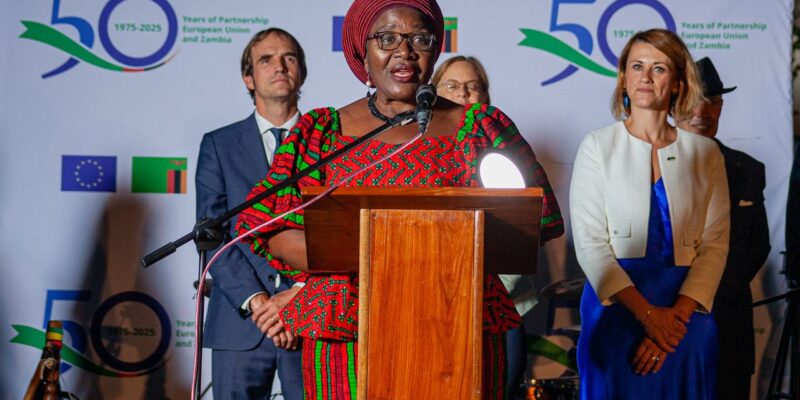
By Jeff Kapembwa
Zambia’s quest to plug climate change buffeting the environment and dwarfing the country’s growth prospects has received a fillip from the European Union with a€500mln grant extended under its Global Gateway Initiative.
In addition to supporting the country’s green growth between 2021-2027, part of the funding will bolster the energy, infrastructure, education, health sectors, and provide an inclusive economic development agenda.
The 28-member-EU-has overly been a partner to Zambia, protecting and sustainably managing the country’s forests through various initiatives, including the Forest Partnership programme.
Finland recently helped in equipping forestry-related colleges in impact skills among students as part of the mitigation.
The 2024-2030 Green Growth Strategy launched in Zambia last seeks to transition the Southern African state towards a green economy by fostering low-carbon, resource-efficient, resilient and socially inclusive growth.
The blueprint is a comprehensive framework designed to align Zambia’s development pathways with principles of sustainability and inclusivity, centering on four pillars: (1) resilient and climate-compatible growth, (2) enhanced resource efficiency, (3) enhanced natural capital and (4) improved inclusivity.
It further provides a roadmap for achieving Zambia’s Vision 2030 and the Eighth National Development Plan (8NDP) objectives, while reaffirming Zambia’s commitment to the Paris Agreement, the Sustainable Development Goals and the Convention on Biological Diversity, according to then former minister of Green Economy, Collins Nzovu at the launch.
The NDC Partnership Global, an initiative to help countries achieve their national climate commitments and ensure financial and technical assistance was delivered efficiently and in real time is happy that Zambia has prioritized the protection of the environment.
“The Green Growth Strategy being launched today represents an opportunity for sustainable growth, but it also represents a development imperative as Zambia looks to address the needs of its citizens in the face of mounting climate impacts,” said its Director, Director Pablo Vieira.
And speaking during the 50th anniversary of EU-Zambia partnership on 9 May EU Ambassador to Zambia Karolina Stasiak said it was the group’s desire to assist Zambia narrow the investment gap.
The gesture will also be extended to facelifting the over 60-year-old Kariba Dam as well as the recent investment in the Zambia–Tanzania Interconnector to enhance regional power trade.
The financing, according to Stasiak, is to expedite Zambia’s green transition through the EU-Zambia Forest Partnership.
The initiative is intended to plug deforestation, promote sustainable forest management, and develop forest-based economic activities.
Labour and Social Security Minister Brenda Tambatamba, during the same occasion hailed the EU for its continued support toward Zambia’s developmental goals under the Eighth National Development Plan.
“Zambia is building resilience in the wake of climate change, which poses a serious threat to both our environment and economic gains,” Tambatamba said.
The EU’s support is part of its pilot of the Green Nexus programme—an inclusive model for green growth that brings together communities, the Government, private sector, and development partners.
The EU has rendered support to Zambia over the years in seeking to protect and sustainably manage its forests through various initiatives, including the Forest Partnership programme.
It earlier pledged €10 million to the Forest Partnership programme and an additional €4 million to support the implementation of the Green Economy and Climate Change Act.
The EU-Zambia Forest Partnership aims to address deforestation, forest degradation, and loss of biodiversity while promoting sustainable forest economies and environmental sustainability.
Key aspects of EU support for Zambia’s forest protection:
• Financial support:
The EU has pledged substantial financial resources, including €10 million for the Forest Partnership programme and an additional €4 million for the Green Economy and Climate Change Act.
• Forest Partnership Programme:
The programme focuses on addressing deforestation, forest degradation, and biodiversity loss, while promoting sustainable forest economies and environmental sustainability.
• Green Economy and Climate Change Act:
The EU supports the implementation of this act, which aims to promote sustainable development and address climate change.
• Sustainable Forest Management:
The EU is working with Zambia to promote sustainable forest management practices, including sustainable agriculture, to minimize deforestation and forest degradation.
• Global Gateway Initiative:
The EU’s Global Gateway initiative, which aims to boost sustainable links with partner countries, is also being used to support the Forest Partnership programme.
Finland has been instrumental in forest conservation. Ambassador Saana Halinen during the 47th graduation ceremony of the Zambia Forestry College in Kitwe last year, reaffirmed her country’s unwavering support to Zambia since 1980
He stated that the country’s support includes support to the forestry sector in Zambia including forestry education. Forestry remains at the heart of Finland’s support to Zambia’s development agenda and technical and skills training are critical for sustainable forest management.’’
The cooperation continues as Häme University of Applied Sciences and Novia University of Applied Sciences are starting a curriculum development project with the college, which is funded by Finland.
